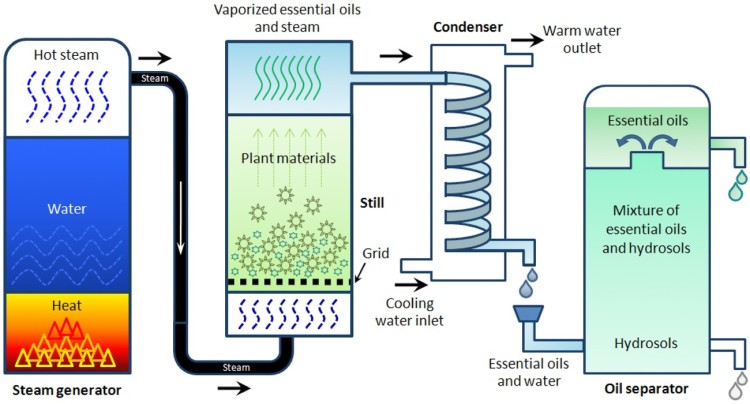
Regarding hydrodistillation, the essential oils industry has developed terminology to distinguish three types: water distillation; water and steam distillation; and direct steam distillation. All methods are subject to the same theoretical considerations which deal with distillation of two-phase systems. The differences lie mainly in the methods of handling the material.
Some volatile oils cannot be distilled without decomposition and thus are usually obtained by expression (lemon oil, orange oil) or by other mechanical means. In certain countries, the general method for obtaining citrus oil involves puncturing the oil glands by rolling the fruit over a trough lined with sharp projections that are long enough to penetrate the epidermis and pierce the oil glands located within outer portion of the peel (ecuelle method). A pressing action on the fruit removes the oil from the glands, and a fine spray of water washes the oil from the mashed peel while the juice is extracted through a central tube that cores the fruit. The resulting oil-water emulsion is separated by centrifugation. A variation of this process is to remove the peel from the fruit before the oil is extracted.
Often, the volatile oil content of fresh plant parts (flower petals) is so small that oil removal is not commercially feasible by the aforementioned methods. In such instances, an odorless, bland, fixed oil or fat is spread in a thin layer on glass plates. The flower petals are placed on the fat for a few hours; then repeatedly, the oil petals are removed, and a new layer of petals is introduced. After the fat has absorbed as much fragrance as possible, the oil may be removed by extraction with alcohol. This process, known as enfleurage, was formerly used extensively in the production of perfumes and pomades.
In the perfume industry, most modern essential oil production is accomplished by extraction, using volatile solvents such as petroleum ether and hexane. The chief advantages of extraction over distillation is that uniform temperature (usually 50° C) can be maintained during the process, As a result, extracted oils have a more natural odor that is unmatched by distilled oils, which may have undergone chemical alteration by the high temperature. This feature is of considerable importance to the perfume industry; however, the established distillation method is of lower cost than the extraction process.
Destructive distillation means distilling volatile oil in the absence of air. When wood or resin of members of the Pinaceae or Cupressaceae is heated without air, decomposition takes place and a number of volatile compounds are driven off. The residual mass is charcoal. The condensed volatile matter usually separates into 2 layers: an aqueous layer containing wood naptha (methyl alcohol) and pyroligneous acid (crude acetic), and a tarry liquid in the form of pine tar, juniper tar, or other tars, depending on the wood used. This dry distillation is usually conducted in retorts and, if the wood is chipped or coarsely ground and the heat is applied rapidly, the yield often represents about 10% of the wood weight used.
Almost all constituents of essential oils are unstable at high temperature. To obtain the best quality oil, distillation must be done at low temperatures. The temperature in steam distillation is determined entirely by the operating pressure, whereas in water distillation and in water and steam distillation the operating pressure is usually atmospheric. All the previously described three effects, i.e. hydrodiffusion, hydrolysis and thermal decomposition, occur simultaneously and affect one another. The rate of diffusion usually increases with temperatures as does the solubility of essential oils in water. The same is true for the rate and extent of hydrolysis. However, it is possible to obtain better yield and quality of oils by:
(1) maintaining the temperature as low as possible,
(2) using as little water as possible, in the case of steam distillation, and
(3) thoroughly comminuting the plant material and packing it uniformly before distillation.

|

|
Currently, there are no comment.
Login to comment